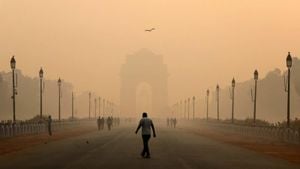The head of the UN’s nuclear watchdog, the International Atomic Energy Agency (IAEA), is gearing up for an important visit to the Kursk nuclear power station located in southwest Russia. This visit is sparked by increasing concerns over the risks posed to the facility amid the conflict involving Ukraine, where artillery operations have been reported nearby.
Rafael Grossi, the IAEA Director-General, expressed his serious apprehensions about the plant's safety during recent talks. He emphasized, “The Kursk plant is technically within artillery range of Ukrainian positions,” pointing directly to the combat situation impacting the region.
Grossi plans to visit the facility next week, primarily to engage with its management and assess any damage incurred. He aims to gather evidence of whether the plant has been targeted amid the chaos surrounding the conflict.
A key aspect of his mission is to understand the current state of the plant's external power supply and the access routes to it. Grossi highlighted the importance of stable supply lines, especially following the destruction of bridges over the Seym River, which had been reported recently by Ukrainian forces.
This visit indicates the IAEA’s proactive stance on nuclear safety, especially when security is compromised by military actions. Grossi's imminent arrival at Kursk highlights how vulnerable facilities can be during conflicts, and the need for thorough inspections to safeguard nuclear resources.
Ukraine's conflict has notorious consequences, not only for the military but also for civilian infrastructure. The potential for radiation hazards or nuclear mishaps looms large if the plant is affected by artillery fire or attacks.
Experts have been closely monitoring the situation, signaling the importance of international oversight to prevent any nuclear disasters stemming from military conflict. Grossi's visit is perceived as both necessary and urgent, signifying the gravity of nuclear oversight under extreme circumstances.
Since the invasion of Ukraine, the IAEA has intensified its scrutiny on nuclear facilities near conflict zones. The agency has been actively focused on maintaining safety and security standards even as tensions rise.
The IAEA’s work is not just about ensuring power generation but also about upholding global nuclear security commitments. Therefore, the team's findings from the Kursk plant could have broader ramifications for international relations and nuclear safety protocols worldwide.
It is evident the IAEA plays a pivotal role, particularly now as geopolitical tensions continue to challenge the proceedings of nuclear oversight. Grossi's forthcoming assessment of the Kursk facility may highlight the precarious balance of maintaining energy security against the backdrop of conflict.
While Grossi takes on this delicate mission, his findings will be closely watched by the global community. The stakes are undeniably high as the safety protocols around nuclear facilities are put to the test against the unpredictable nature of wartime activities.
Russia's continued military operation raises alarms not just for them but for all surrounding nations and the international community at large. There’s heightened awareness about the need for clear communication and transparent action, particularly in managing these high-risk environments.
With the situation continually developing, the focus on the IAEA’s findings will likely steer future discussions on nuclear safety and conflict resolution. The global community has its eyes set firmly on Kursk, recognizing it as central to conversations about international nuclear safety.
For many, this inspection at Kursk is more than just about checking equipment; it’s about safeguarding human lives and making sure history doesn’t repeat itself. It reflects a growing concern for nuclear safety amid the modern challenges of geopolitical instability.



